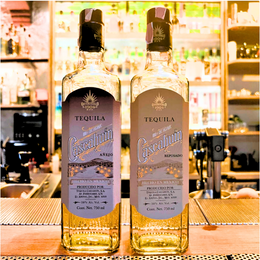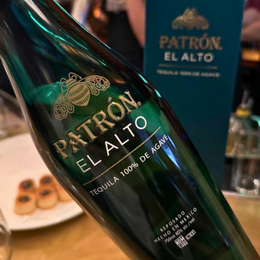
This is a continuation of the story of my Vancouver trip.
One thing I didn’t expect in Vancouver was to find and drink a lot of Tequila. After all, Canada is notorious for not having a good variety of booze (a store called Legacy Liquor has a really good selection of wines and spirits, though). So, I thought I’d just end up finding the usual brands like Patron and Don Julio. In my portion of Malt’s Review of 2022, I shared links that mentioned the growth of agave spirits in North America. This growth is even beating the sales of vodka.
To be clear, it wasn’t my intent to drink a lot of Tequila in Vancouver. I was hoping to try Canadian wines like those from Painted Rock and Le Vieux Pin.; thankfully I was able to buy bottles from these wineries. Maybe even Canadian whisky. But it seems like the (aged) tequila bug bit my relatives who were with me. So, on nights when we’d drink together in our hotel rooms, tequila was our drink of choice. Bottles of reposados and añejos from brands such as Clase Azul, Adictivo, Storywood Speyside, and Tromba were consumed.
I’m not sure of the history of these Tequila brands. Honestly, I’m feeling lazy to find out how new or old these brands are. I largely blame/credit this tequila trend to the brands owned by celebrities. George Clooney’s-turned-Diageo’s Casamigos, The Rock’s Teramana, and Kendall Jenner’s 818 come to mind. The surfacing of new and less familiar tequila brands is reminiscent of that gin boom we had close to ten years ago. Basically, it was the entrance of loads of new brands into the market. but so few of them were exciting. A whole lot more crap than craft, if I were to turn off my mental filter.

Tequila isn’t a spirit I’ve really taken a deep dive on. But I know enough to know that it’s a category that can’t be as exciting as Mezcal. For one, Tequila can only use the Blue Weber agave for its production, mhile Mezcal can use way more agave varieties. Think of this from the perspective of wine. where only one type of grape can be used for product X (Tequila), while product Z (Mezcal) can use more grape varieties. Which would you give more attention to? A few years ago, there were discussions of there being differences between Blue Weber agaves coming from the highlands and the valleys, but it seems to have died down.
Another issue I have with this tequila trend is that most of those who are drinking them are whisk(e)y drinkers, which means that they’re going for the aged expressions. I see this as sort of a disingenuous way to drink agave spirits because, traditionally, agave spirits didn’t spend time in oak casks. Traditionally, agave spirits were aged or rested in neutral containers like clay jars and plastic jugs, although I’ve read of some mezcal being stored in leather containers. The addition of oak influence masks the agave character, or masks its flaws. Plus, more tequila brands are made with modern or efficient techniques, meaning column stills, short fermentations, and efficient ways to cook the agave are involved. All of these reduce the flavor of the agave to cater to the market who mostly wants a “smooth” product.
The trip took me back to my visit to Tommy’s Mexican Restaurant, aka Tommy’s, in San Francisco a few years ago. For those unaware, this place is known for being managed by Julio Bermejo. The name of the place comes from his father, Tomas, who established the restaurant in 1965 along with his wife.
Julio is probably the best and most recognized tequila expert out there. He’s also one of the biggest tequila advocates in the world. Aside from these, he created the wonderful modern classic that is Tommy’s Margarita.
Because this was back in 2018, I’m going to paraphrase bits of what Julio told me. When tequila was new to the US market, it was mostly mixtos. So, the available brands weren’t made with 100% agave. Being a 100% agave tequila advocate, one of the few 100% agave tequilas he could frequently rely on was Herradura.
Herradura is a brand of tequila that was created in 1870 by Felix Lopez. However, in 2007, it was acquired by Brown-Forman. In between those years, though, there were a flurry of ownership changes also.
I’m mainly reviewing this because of what Julio told me, even though it’s now owned by the same folks who make Jack Daniel’s, which makes it more likely the product is no longer what it was. It still deserves to be reviewed. Note that when I was in Tommy’s, Julio was using more Tapatio than other brands.
P.S. If you’re ever in San Francisco, I suggest you visit Tommy’s. The drinks, food. and service there are great. Should you be lucky to bump into Julio, you’ll be in for a treat. He’s one of the best hosts I’ve ever encountered. Safe to say he’s a great human being. Everyone only has good things to say about him.

Herradura Plata – Review
40% ABV. £40.95 from The Whiskey Exchange.
Color: Mostly amber.
On the nose: I get light to medium aromas of agave, bell peppers, pepperiness, palm sugar and agave syrup. Around it is an enveloping aroma of sweet-ish nuttiness. It makes me think of peanut candy shavings. The type used for the ice cream and peanut wrap in Taipei.
In the mouth: I get light tastes of agave, agave syrup, bell peppers and palm sugar. There’s still this enveloping taste of peanut candy shavings but it’s not as bold.
Conclusions:
A Tequila with decent flavor that’s slightly better than the usual big brand owned ones like Patron and Don Julio. But it lacks texture, likely due to the ABV. The pepperiness in this adds a bit of complexity though. Also, this has been slightly aged, which gives the color. The maximum amount of aging plata – or silver tequila – can undergo is up to 60 days.
Score: 5/10
Lead image courtesy of John Go.
|
John is a cocktail and spirits enthusiast born and raised in Manila. His interest started with single malts in 2012, before he moved into rum and mezcal in search of malterntaitves – and a passion for travel then helped build his drinks collection. |







